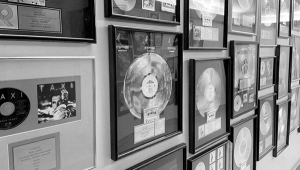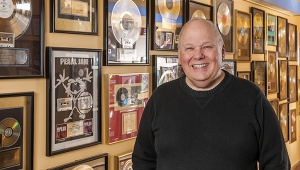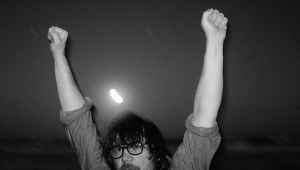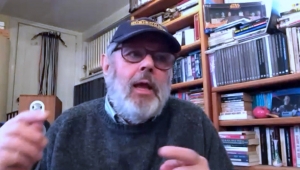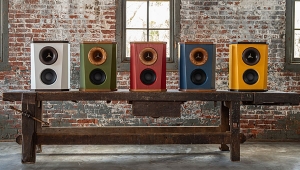| Columns Retired Columns & Blogs |
Paul Barton: It Doesn't Get Much Better Than That Page 6
Atkinson: The Stratus Gold i is a stereo loudspeaker, yet as with every other speaker company, home theater is obviously having an impact on your product mix. Do you see surround systems ultimately replacing two-channel stereo? And if so, do you have to design speakers somewhat differently?
Footnote 1: "Listening Tests—Turning Opinion into Fact," presented at the 69th Convention of the Audio Engineering Society (1981 May). Preprint 1766. JAES, Vol.33, pp.439-440 (1982 June). "Subjective Measurements of Loudspeaker Sound Quality and Listener Performance," JAES, Vol.33, pp.9-12 (1985 January/February). "Loudspeaker Measurements and their Relationship to Listener Preferences: Part 1," JAES, Vol.34, p.231 (1986 April). "Loudspeaker Measurements and their Relationship to Listener Preferences: Part 2," JAES, Vol.34, pp.335-336 (1986 May). All by Floyd E. Toole. "The Perception of Sound Coloration Due to Resonances in Loudspeakers and Other Audio Components," presented at the 81st Convention of the Audio Engineering Society (1986 November). Preprint 2406. "The Modification of Timbre by Resonances: Perception and Measurement," presented at the 83rd Convention of the Audio Engineering Society (1987 October). Preprint 2487. Both by Floyd E. Toole and Sean E. Olive, both of whom are now at Harman International.—JA
Barton: Well, you have to create an SKU that offers a wider variety of applications now because of home theater. I don't think the stereo business is growing, but I don't think it's diminishing. But PSB's growth, as is the case with all speaker companies, is driven by home theater right now. And answering your question, yes, you can achieve very similar performance levels with different combinations: subwoofers, small satellites, large front speakers, large center channel...the sky's the limit. The challenge for PSB was to try to quickly adapt to all these different product categories being demanded because of home theater.
Atkinson: Where are we going with loudspeaker design?
Barton: The NRC, in conjunction with a consortium of Canadian companies—PSB, Paradigm, all the API group, and a small, high-powered studio monitor manufacturer centered in Ottawa called State-of-the-Art Electronics, better known as SOTA (not to be confused with the turntable company)—organized research in pursuit of adaptive loudspeakers, what we coined "smart loudspeakers." This Athena project was a 3½-year project, and I think approximately $1 million was spent doing the research. That's not a lot of money for big companies, but there aren't too many loudspeaker companies that can throw $1 million at pure research.
A lot was learned through that project. When you were in Ottawa, you were witness to some of the final results.
Atkinson: To sum up my reaction and that of Tom Norton, what we heard was the digital correction of a pair of original Stratus Golds in the newer L-shaped room at NRC. When the speakers were put in obviously suboptimal positions, the improvement in their sound was remarkable. But when the speakers were placed where an audiophile would intuitively put them in the room, while there was still an improvement, particularly in imaging, it was actually quite subtle.
Barton: I'm glad that you noticed the [improvement in the] bad position, because there are some lifestyle restrictions that people place on systems in homes, and benefits could be achieved by DSP. But I think the consensus is that you have to throw a huge amount of money at the problem, but the result is currently beyond the point of diminishing returns. But we're looking at possibly taking that kind of technology into a very affordable range. What the future holds is little black boxes that can enhance loudspeakers and do some DSP things that will improve the performance of the loudspeaker for both home-theater and stereo applications. It is possible that we will integrate [the DSP] with full-range powered speakers that really need just a digital source, not unlike what Meridian does in some of their products. I think that's becoming feasible in an affordable range of speakers costing, say, under $4000 for a system.
There's another area that I'd like to develop, working in conjunction with some research going on at NRC that involves active noise control. How that translates to hi-fi reproduction is active absorption, which is the opposite of an adaptive loudspeaker. It sort of "anti-adapts" to the acoustic environment. At low frequencies, I think this could be very effective. I remember years ago there was a tall, slim column called the Black Shadow. Who made that?
Atkinson: Nelson Pass designed it for Threshold at the end of the '80s. The time I heard it, it certainly seemed to kill the low-frequency room resonances...
Barton: You put it in the corner and pump up the opposite modes, right?Footnote 1
Atkinson: Yeah.
Barton: So anyway, as far as the future is concerned, even though you haven't heard a lot from the Canadian contingent or any of the specific Athena companies about DSP, you can bet that it's actively on the table.
Atkinson: What about the flat speakers that have been promoted by NXT in England and NCT in America? Or the so-called "HyperSonic Sound" being promoted by American Technology Corporation and Carver in the US? In 20 years' time, will audiophiles still be listening to a much-refined version of Rice and Kellogg's moving-coil drive-unit?
Barton: I don't think things are going to change that much. As far as flat speakers are concerned, they have technical hurdles that I can't think of ways to overcome. I think when it comes to customers being able to afford it and appreciate good sound, the conventional box loudspeaker is pretty hard to beat. This may sound a little egotistical, I don't know, but it doesn't get much better than that.
Atkinson: Paul is pointing to the Gold i. [laughter]
Barton: I mean, yes, it does get better, but as you described when hearing the DSP enhancement of a system, improvements beyond that are described as being more subtle than dramatic. The late Peter Mitchell probably said it best: As we become more and more critical, the power of the magnifying glass gets stronger and stronger so that much smaller differences are perceived as being much larger. I think we're going through that phase in loudspeakers right now.
Atkinson: Here at the magazine, it's quite a rare event when we get a loudspeaker that has an obviously identifiable midrange coloration. In fact, we tend to call each other up and say, "Come and listen to this." You get so used to loudspeakers conforming to a basic level of neutrality.
Barton: I'm just taking a snapshot in time and I'm saying it doesn't get much better than that—right now. Five years from now, I may point to a speaker that is much better than [the Gold i] and say, "It doesn't get much better than that."
Footnote 1: "Listening Tests—Turning Opinion into Fact," presented at the 69th Convention of the Audio Engineering Society (1981 May). Preprint 1766. JAES, Vol.33, pp.439-440 (1982 June). "Subjective Measurements of Loudspeaker Sound Quality and Listener Performance," JAES, Vol.33, pp.9-12 (1985 January/February). "Loudspeaker Measurements and their Relationship to Listener Preferences: Part 1," JAES, Vol.34, p.231 (1986 April). "Loudspeaker Measurements and their Relationship to Listener Preferences: Part 2," JAES, Vol.34, pp.335-336 (1986 May). All by Floyd E. Toole. "The Perception of Sound Coloration Due to Resonances in Loudspeakers and Other Audio Components," presented at the 81st Convention of the Audio Engineering Society (1986 November). Preprint 2406. "The Modification of Timbre by Resonances: Perception and Measurement," presented at the 83rd Convention of the Audio Engineering Society (1987 October). Preprint 2487. Both by Floyd E. Toole and Sean E. Olive, both of whom are now at Harman International.—JA
- Log in or register to post comments

